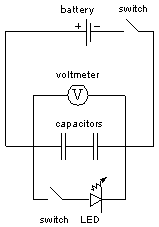Experimental work performed by Jerrad Businger and Grace Faruk.
When we measured the current from a single lemon cell (electrodes: galvanized screw and heavy copper wire), we got less than 20 microamperes, that's less than 20 one-millionths of an ampere. (20 μA is the lower limit of our multimeter.)Get a multimeter (from Radio Shack or an electronics repair store) and measure the volts and amps coming from your food battery. The folks at Radio Shack should be able to help you learn to use the thing.
Light bulbs not only require substantial voltage (typically 1.5V to 3V for flashlight bulbs) but substantial amperage.
Look it up. How do light bulbs produce light? Why do they get so hot that a 100-watt light bulb is the heat source for the Easy-Bake Oven?So a light bulb is NOT likely to work with a single fruit battery, despite what I said in my Mad Scientist answer.
See also the Lemon Power Project from EnergyQuest.
See also Dr Dan's Lemon Power Website. Warning: Dr. Dan gives results using magnesium metal. Magnesium is inflammable, it burns hot enough to cause severe damage to anything you set it on, and you cannot put it out with water.
Caution:
- LEDs are one-way devices. They only work if they are placed in the circuit correctly. Worse, they burn out if placed in the circuit backwards. So get a dozen or so. Then learn which way is which!
- LEDs require a certain minimum voltage. So make sure that you have it before deciding the LEDs don't work.
- LEDs burn out at ridiculously low current levels (amperage). Check the volt/amp rating on your LEDs, and be prepared to use resistors to reduce the current if necessary. You can get resistors at the same place you got the LEDs.
- Things to look up in a textbook. Why do you need two different metals? Where do the electrons come from, and where do they go? Which electrode is positive, and which is negative?
- Things to think about. If what you found is true, why do you need the piece of fruit? What else might work?

|
| Experimental work performed by Jerrad Businger and Grace Faruk. |
For a light bulb you need more than an ampere--even LEDs require several milliamperes--and a food battery puts out current in the microampere range--so you'd need a million of 'em, literally, to light a bulb directly. However, you can charge a capacitor with a lemon cell--and eventually you'll have enough juice stored in the capacitor to light up an LED or even a light bulb. A circuit diagram that uses capacitors to light an LED is shown at right. Remember that both LEDs and capacitors are one-way devices and only work when hooked up in the proper direction!
Another suggestion (from Purdue University) to get more power from your lemon:
- Connect a zinc and a copper electrode with a jumper cable.
- Place the copper electrode near your first zinc electrode, and the zinc electrode near your first copper electrode. This increases your power by lowering the internal resistance of the cell.
- Repeat (carefully) as needed, testing for voltage and amperage each time.
Remember, experimental work is full of setbacks. Don't be discouraged.
See also the Lemon Power Project from EnergyQuest.
See also Dr Dan's Lemon Power Website Warning: Dr. Dan gives results using magnesium metal. Magnesium is inflammable, it burns hot enough to cause severe damage to anything you set it on, and you cannot put it out with water.
See also this demonstration (from Purdue University) of a lemon-powered digital clock. Something like this can be purchased from Edmund Scientific (search for "potato clock" or "water clock")